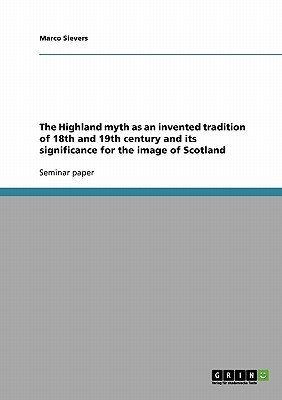
- We will send in 10–14 business days.
- Author: Marco Sievers
- Publisher: GRIN Verlag
- Year: 2007
- Pages: 64
- ISBN-10: 3638816516
- ISBN-13: 9783638816519
- Format: 14.8 x 21 x 0.4 cm, softcover
- Language: English
- SAVE -10% with code: EXTRA
The Highland myth as an invented tradition of 18th and 19th century and its significance for the image of Scotland (e-book) (used book) | bookbook.eu
Reviews
Description
Seminar paper from the year 2005 in the subject English Language and Literature Studies - Culture and Applied Geography, grade: 2, University of Hannover, course: Peripheries in British 19th-Century History: Scotland and Ireland, language: English, abstract: If people around the globe are asked what they associate with Scotland or the Scots, tartan kilts, bagpipes, clans and the Highlands are the most common answers. Especially tourist interest concentrates on these landmarks of Scotland, which are said to be insignias of Scottish tradition, glory and identity, and which dominate the image of Scotland. But are these landmarks really linked to a tradition from times immemorial? Do they really represent a link to Scotland's Gaelic roots? This paper will investigate this question by introducing Eric Hobsbawm´s term of "invented tradition" to denote and to outline the process of creation of these Scottish symbols. The following portrait of the historical background will show the social, political and economic developments in the 18th and 19th century which led to the invention of tradition as part of the creation of a Highland myth as a result of and as reaction to Scotland's union with England in 1707. Furthermore, the worldwide spreading of the Highland myth, which has determined the image of whole Scotland ever since, will be described. The paper will finish by showing contemporary parallels to the historic developments and trends, and suggesting further topics of investigation.
EXTRA 10 % discount with code: EXTRA
The promotion ends in 12d.04:39:53
The discount code is valid when purchasing from 10 €. Discounts do not stack.
- Author: Marco Sievers
- Publisher: GRIN Verlag
- Year: 2007
- Pages: 64
- ISBN-10: 3638816516
- ISBN-13: 9783638816519
- Format: 14.8 x 21 x 0.4 cm, softcover
- Language: English English
Seminar paper from the year 2005 in the subject English Language and Literature Studies - Culture and Applied Geography, grade: 2, University of Hannover, course: Peripheries in British 19th-Century History: Scotland and Ireland, language: English, abstract: If people around the globe are asked what they associate with Scotland or the Scots, tartan kilts, bagpipes, clans and the Highlands are the most common answers. Especially tourist interest concentrates on these landmarks of Scotland, which are said to be insignias of Scottish tradition, glory and identity, and which dominate the image of Scotland. But are these landmarks really linked to a tradition from times immemorial? Do they really represent a link to Scotland's Gaelic roots? This paper will investigate this question by introducing Eric Hobsbawm´s term of "invented tradition" to denote and to outline the process of creation of these Scottish symbols. The following portrait of the historical background will show the social, political and economic developments in the 18th and 19th century which led to the invention of tradition as part of the creation of a Highland myth as a result of and as reaction to Scotland's union with England in 1707. Furthermore, the worldwide spreading of the Highland myth, which has determined the image of whole Scotland ever since, will be described. The paper will finish by showing contemporary parallels to the historic developments and trends, and suggesting further topics of investigation.


Reviews